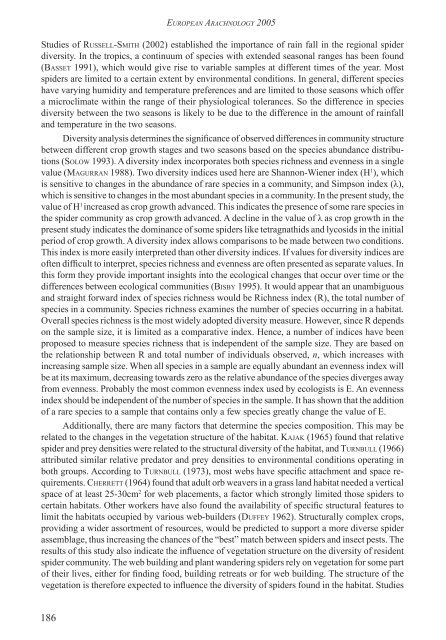Sudhikumar AV, Mathew JM, Sunish E & Sebastian PA - European ...
Sudhikumar AV, Mathew JM, Sunish E & Sebastian PA - European ...
Sudhikumar AV, Mathew JM, Sunish E & Sebastian PA - European ...
Create successful ePaper yourself
Turn your PDF publications into a flip-book with our unique Google optimized e-Paper software.
186<br />
EuropEan arachnology 2005<br />
Studies of russEll-smith (2002) established the importance of rain fall in the regional spider<br />
diversity. In the tropics, a continuum of species with extended seasonal ranges has been found<br />
(BassEt 1991), which would give rise to variable samples at different times of the year. Most<br />
spiders are limited to a certain extent by environmental conditions. In general, different species<br />
have varying humidity and temperature preferences and are limited to those seasons which offer<br />
a microclimate within the range of their physiological tolerances. So the difference in species<br />
diversity between the two seasons is likely to be due to the difference in the amount of rainfall<br />
and temperature in the two seasons.<br />
Diversity analysis determines the significance of observed differences in community structure<br />
between different crop growth stages and two seasons based on the species abundance distributions<br />
(soloW 1993). A diversity index incorporates both species richness and evenness in a single<br />
value (magurran 1988). Two diversity indices used here are Shannon-Wiener index (H 1 ), which<br />
is sensitive to changes in the abundance of rare species in a community, and Simpson index (λ),<br />
which is sensitive to changes in the most abundant species in a community. In the present study, the<br />
value of H 1 increased as crop growth advanced. This indicates the presence of some rare species in<br />
the spider community as crop growth advanced. A decline in the value of λ as crop growth in the<br />
present study indicates the dominance of some spiders like tetragnathids and lycosids in the initial<br />
period of crop growth. A diversity index allows comparisons to be made between two conditions.<br />
This index is more easily interpreted than other diversity indices. If values for diversity indices are<br />
often difficult to interpret, species richness and evenness are often presented as separate values. In<br />
this form they provide important insights into the ecological changes that occur over time or the<br />
differences between ecological communities (BisBy 1995). It would appear that an unambiguous<br />
and straight forward index of species richness would be Richness index (R), the total number of<br />
species in a community. Species richness examines the number of species occurring in a habitat.<br />
Overall species richness is the most widely adopted diversity measure. However, since R depends<br />
on the sample size, it is limited as a comparative index. Hence, a number of indices have been<br />
proposed to measure species richness that is independent of the sample size. They are based on<br />
the relationship between R and total number of individuals observed, n, which increases with<br />
increasing sample size. When all species in a sample are equally abundant an evenness index will<br />
be at its maximum, decreasing towards zero as the relative abundance of the species diverges away<br />
from evenness. Probably the most common evenness index used by ecologists is E. An evenness<br />
index should be independent of the number of species in the sample. It has shown that the addition<br />
of a rare species to a sample that contains only a few species greatly change the value of E.<br />
Additionally, there are many factors that determine the species composition. This may be<br />
related to the changes in the vegetation structure of the habitat. kajak (1965) found that relative<br />
spider and prey densities were related to the structural diversity of the habitat, and turnBull (1966)<br />
attributed similar relative predator and prey densities to environmental conditions operating in<br />
both groups. According to turnBull (1973), most webs have specific attachment and space requirements.<br />
chErrEtt (1964) found that adult orb weavers in a grass land habitat needed a vertical<br />
space of at least 25-30cm 2 for web placements, a factor which strongly limited those spiders to<br />
certain habitats. Other workers have also found the availability of specific structural features to<br />
limit the habitats occupied by various web-builders (duffEy 1962). Structurally complex crops,<br />
providing a wider assortment of resources, would be predicted to support a more diverse spider<br />
assemblage, thus increasing the chances of the “best” match between spiders and insect pests. The<br />
results of this study also indicate the influence of vegetation structure on the diversity of resident<br />
spider community. The web building and plant wandering spiders rely on vegetation for some part<br />
of their lives, either for finding food, building retreats or for web building. The structure of the<br />
vegetation is therefore expected to influence the diversity of spiders found in the habitat. Studies
















